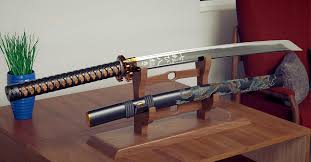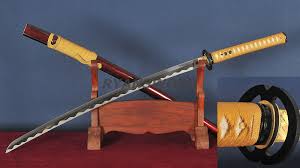The Japanese Katana sword is more than just a weapon; it’s a symbol of art and history. Imagine the gleam of a perfectly forged blade, sharp enough to cut through silk. The magic lies in the ancient forging process, a craft passed down through generations. Without this meticulous method, a Katana wouldn’t possess its legendary strength and beauty. Dive in to uncover the secrets behind these fascinating swords.
Table of Contents
The History of Katana Sword Forging
The history of Katana Sword forging is a fascinating journey through time. Let’s explore how this ancient craft evolved into the legendary art it is today.
Ancient Beginnings
The history of Katana sword forging starts in ancient Japan. It began during the Heian period, around the 8th century. At that time, blacksmiths made straight, single-edged swords. These early swords were more tools than the beautiful Katanas we know today.

Birth of the Curved Blade
By the Kamakura period, around the 12th century, the design changed. Blacksmiths found that a curved blade worked better in fights. This discovery led to the creation of the classic Katana shape. The curved blade could easily slice through armor. This period marked the true start of Katana crafting.
Improving the Craft
Over the centuries, techniques improved. During the Muromachi period, the forging process got better. Blacksmiths started folding the steel many times. This method removed impurities and made the blade stronger. Each fold added to the blade’s strength and sharpness.
The Edo Era Mastery
In the Edo period, blacksmiths took their skills to the next level. They perfected the differential hardening technique. By coating the blade with clay before cooling, they made a hard edge and a softer spine. This gave the Katana its special strength and flexibility. The unique Hamon line, a result of this process, became a mark of quality.
From ancient beginnings to modern times, the history of Katana forging is a story of constant improvement. Each era brought new methods and refinements, shaping the Katana into the legendary sword it is today.
Essential Materials in Katana Forging
The materials used in forging a Katana are as unique as the sword itself. Let’s delve into the key components that make these swords exceptional.
Tamahagane Steel – The Heart of the Katana
Tamahagane steel is the main material used to forge a Katana. This special steel comes from iron sand, which has a lot of iron. The process begins by heating the iron sand in a furnace called a tatara. This creates Tamahagane steel.
The steel is then broken into pieces, sorted, and refined. What makes Tamahagane unique is its carbon content. It has both high and low carbon steel. High carbon steel makes the blade hard and sharp. Low carbon steel gives it flexibility and strength. This mix is crucial for making a strong and durable Katana.
Other Essential Materials
Apart from Tamahagane steel, other materials play important roles in the forging process.
1. Clay:
Used in the differential hardening process. It helps create the hard edge and softer spine.
2. Charcoal:
Acts as the fuel in the tatara furnace. It is essential for maintaining high temperatures.
3. Water:
Used for quenching the hot blade. The temperature and method of quenching are critical for achieving the desired hardness.
4. Ash and Sand:
Used to refine and purify the steel further. They help remove impurities during the folding process.
Each of these materials is crucial in creating a high-quality Katana. Together, they ensure the blade’s strength, sharpness, and beauty.
The Traditional Katana Forging Process
The traditional forging process of a Katana is a detailed art. Let’s explore the key steps that Japanese Online Store uses to create this legendary sword.
Smelting: Creating Tamahagane Steel
- Iron Sand:
Start with iron sand, which is rich in iron.
- Tatara Furnace:
Heat the iron sand in a special furnace called a tatara.
- High Temperature:
The furnace reaches about 1,200 degrees Celsius.
- Melting:
The iron sand melts, creating a bloom of steel called Tamahagane.
- Breaking and Sorting:
Break the steel bloom into smaller pieces. Sort these pieces by their carbon content.
-
- High Carbon Steel:
Set aside for the blade’s edge.
-
- Low Carbon Steel:
Used for the core of the blade.
Folding the Steel: Purity and Strength
- Heating the Steel:
Heat the Tamahagane steel until it becomes red-hot.
- Hammering and Folding:
Hammer the steel flat and fold it over itself.
- Repeating the Process:
Repeat this folding process multiple times, sometimes up to 16 folds.
- Removing Impurities:
Each fold helps to remove impurities from the steel.
- Distributing Carbon:
Folding also spreads the carbon evenly throughout the steel.
- Creating Layers:
The final billet of steel has thousands of layers.
- Unique Grain Pattern:
Folding creates a unique and beautiful grain pattern on the blade.
- Strength and Flexibility:
The layers make the blade strong and flexible. It can hold a sharp edge and absorb shocks without breaking.
The traditional forging process, from smelting to folding, showcases the skill and dedication of Japanese blacksmiths. Each step transforms raw materials into a legendary weapon, ensuring the blade’s purity, strength, and beauty.

Unique Forging Techniques of Katana Swords
Forging a Katana involves special techniques that give the blade its unique properties. Let’s explore two key techniques: differential hardening and clay tempering.
Differential Hardening: Unique Hardening Process
- Heating the Blade:
The process starts by heating the blade evenly until it becomes red-hot.
- Quenching:
The blade is quickly cooled, or quenched, in water or oil.
- Edge Hardening:
The edge of the blade cools rapidly, becoming very hard.
- Soft Spine:
The spine cools more slowly, staying softer and more flexible.
- Balanced Properties:
This creates a blade that is hard enough to hold a sharp edge, yet flexible enough to absorb impacts.
Differential hardening gives the Katana its distinctive combination of hardness and flexibility. This process is crucial for a blade that can perform well in combat without breaking.
Clay Tempering: Creating the Hamon Line
- Applying Clay:
Before heating, the blade is coated with a special clay mixture.
- Thick and Thin Layers:
The edge is covered with a thin layer of clay, while the spine gets a thicker layer.
- Controlled Cooling:
The clay slows the cooling process for different parts of the blade.
- Distinctive Hamon Line:
This process creates a visible wavy line along the edge, known as the Hamon.
- Symbol of Quality:
The Hamon is not just decorative; it shows the quality of the tempering process.
Clay tempering is a crucial step in making a Katana. It enhances the blade’s strength and gives it a beautiful, distinctive appearance.
Testing the Katana
Testing a Katana is vital to make sure it is sharp and strong. Let’s look at how these swords are tested.
Quality Assurance: Sharpness and Durability
- Sharpness Tests:
The blade is tested by cutting through materials like bamboo, straw mats, and silk.
- Durability Checks:
The blade is struck against hard objects to check for cracks or weaknesses.
- Flexibility Tests:
The sword is bent slightly to see if it bends without breaking.
- Edge Retention:
The blade is used repeatedly to see if it stays sharp. A good Katana should remain sharp after many uses.
- Inspection:
Skilled craftsmen look closely at the blade for any flaws or inconsistencies.
Traditional Tests: Historical Methods
- Tatami Cutting:
Historically, Katanas were tested on rolled-up tatami mats. These mats are similar to the density of flesh and bone.
- Armor Cutting:
In some tests, the blade had to cut through layers of armor. This ensured it could perform well in battle.
- Animal Carcasses:
Sometimes, animal carcasses were used to test the blade’s cutting power. This showed how well the Katana could cut through flesh.
- Tameshigiri:
This traditional test involves cutting through bundled straw or bamboo. It tests both the blade and the swordsman’s skill.
- Visual Inspection:
Historically, sword masters inspected the blade closely. They looked at the Hamon line, the steel’s grain, and the overall finish.
Testing a Katana involves careful steps to ensure it is sharp and strong. From ancient methods to modern checks, these tests guarantee that a Katana is a masterpiece of strength and beauty.
Forging a Japanese Katana is a beautiful blend of art and skill. Each step, from smelting to tempering, showcases the dedication and expertise of the blacksmiths. The result is a blade that is strong, flexible, and stunning. Dive deeper into the world of Katanas to appreciate their craftsmanship even more. Explore our collection and find the perfect Katana to add to your own story.
